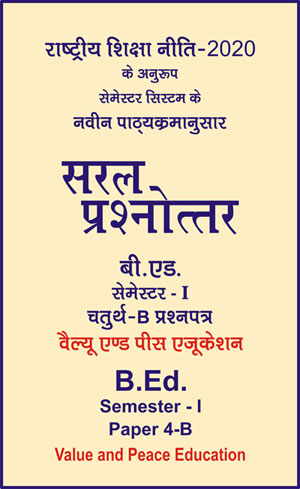|
बी एड - एम एड >> बी.एड. सेमेस्टर-1 प्रश्नपत्र-IV-B - वैल्यू एण्ड पीस एजुकेशन बी.एड. सेमेस्टर-1 प्रश्नपत्र-IV-B - वैल्यू एण्ड पीस एजुकेशनसरल प्रश्नोत्तर समूह
|
5 पाठक हैं |
||||||
बी.एड. सेमेस्टर-1 प्रश्नपत्र-IV-B - वैल्यू एण्ड पीस एजुकेशन (अंग्रेजी भाषा में)
Question- Write a short note on UNESCO. Explain its objectives and conventions also.
Answer -
United Nations Educational, Scientific and Cultural Organization (UNESCO) is a specialized agency of the United Nations (UN). It seeks to build peace through international cooperation in Education, the Sciences and Culture. UNESCO develops educational tools so as to help humanity live in a world free of intolerance and hate. It works in preserving the cultural heritage of the world’s many cultures and also promotes the equal dignity of all cultures. It also engages in advancing scientific programmes and policies as platforms for cooperation and development. UNESCO is also known for advocating the freedom of expression and stands up against the killing of journalists. Although officially founded as UNESCO in 1945, the organisation had its origins in the League of Nations itself. The Constitution of UNESCO came into force in 1946. UNESCO is headed by its Director-General.
It is also a member of the United Nations Sustainable Development Group (UNSDG), a coalition of UN agencies and organizations aimed at fulfilling the Sustainable Development Goals (SDGs).
(1) UNESCO’s Headquarters are located in Paris and the Organization has more than 50 field offices around the world.
(2) It has 193 Members and 11 Associate Members (As of April 2020) and is governed by the General Conference and the Executive Board.
(a) Three UNESCO member states are not UN members: Cook Islands, Niue, and Palestine.
(b) While three UN member states (Israel, Liechtenstein, United States) are not UNESCO members. The US and Israel pulled out in 2019 citing bias in the organisation in the Palestine issue. The US had pulled out of UNESCO once earlier in 1984 and then rejoined in 2003.
Objectives of UNESCO
(1) Attaining quality education for all and lifelong learning
(2) Mobilizing science knowledge and policy for sustainable development
(3) Addressing emerging social and ethical challenges
(4) Fostering cultural diversity, inter-cultural dialogue and a culture of peace
(5) Building inclusive knowledge societies through information and communication
(6) Focuses on global priority areas “Africa” and “Gender Equality”.
Culture Conventions of UNESCO
These conventions have helped in the protection and preservation of the natural and cultural heritage of the world.
(1) Convention on the Means of Prohibiting and Preventing the Illicit Traffic of Cultural Property (1970).(2) Convention for the Protection of the World Cultural and Natural Heritage (1972).
(3) Convention on the Protection of the Underwater Cultural Heritage (2001).
(4) Universal Declaration on Cultural Diversity (2001).
(5) Convention for the Safeguarding of the Intangible Cultural Heritage (2003).
(6) Convention on the Protection and Promotion of the Diversity of Cultural Expressions (2005).
The constitution of UNESCO was signed in London on 16 November 1945 by 37 countries and came into force with its 20th ratification on 4 November 1946.
The purpose of the organization was defined as:
"To contribute to peace and security by promoting collaboration among nations through education, science, and culture in order to further universal respect for justice, for the rule of law, and for the human rights and fundamental freedoms which are affirmed for the peoples of the world, without distinction of race, sex, language, or religion, by the charter of the United Nations."
Today, after more than 60 years of existence, UNESCO functions as a laboratory of ideas and a standard setter to forge universal agreements on emerging ethical issues.
|
|||||













